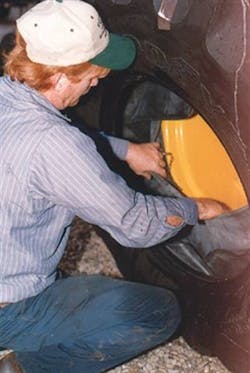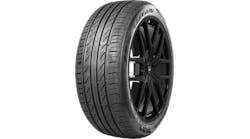Liquid ballast helps farmers get a grip: But the radial revolution may change the rules
When all farm tires were bias-ply construction, choosing the right ballast -- in most cases, calcium chloride -- was easy. But things are changing now that more tractors are leaving the factory with radial tires.
Some tiremakers advise against putting calcium chloride in radial farm tires. "We do not recommend calcium chloride (in radials)... due to power hop," says Len Wagner, manager of field engineering for Firestone Agricultural Tire Co. (FATC). Continental Tire North America Inc. officials say their radial farm tires perform better with air in them than with liquid ballast. "Our preference is dry, or cast, weight on tubeless tires," according to Goodyear.
Many tractor manufacturers feel the same way. For example, John Deere & Co. tells farmers to attach cast-iron weights to their tractors for ballast.
But don't count calcium chloride out yet. Almost every farm tire manufacturer makes bias-ply ag tires, and there are plenty of them in the field. "Calcium chloride can be used in any bias farm tire," Wagner says. In fact, the companies that build farm tire service trucks even report that sales of calcium chloride pumping systems on new orders are steady, and, in one case, slightly up.
Steady demand
"Many farmers are comfortable with calcium chloride ballast because that's what dad used," says Neil Raysen, Continental's farm tire specialist. Some, he adds, are unwilling to switch to dry weights due to their cost.
Fifty-percent of Leroy, Minn.-based tire dealer Randy Estervold's farm tire customers still demand liquid fill. "The large grain farmers with their big, new tractors don't use it much, but the smaller farmers with 'chore' tractors still do."
Chore tractors -- older units used year-round to tow food out to livestock, pick up bales and clean feed lots -- need all the traction they can get, he says. "I have a 7,000-gallon tank of calcium chloride at my dealership and it's just half-full right now." Each of the long-time dealer's seven farm tire service trucks is equipped with a pumping system and a 400-gallon tank.
Estervold says he sometimes pumps calcium chloride into a radial farm tire if the soil is saturated with water. "This will help the farmer (avoid) slippage. But when the soil turns dry, I evacuate the calcium chloride so he can get the full benefit of radial-ply technology."
Don Nebelsick, president of Don's Tire & Supply in Abilene, Kan., is more blunt about the use of calcium chloride in radials. "The effect of putting liquid ballast into a radial is to turn it into a bias-ply tire!"
Pumping liquid ballast into a farm radial "stiffens the sidewall, which, in turn, creates a narrower footprint. It defeats the (other) technologies built into radial farm tires such as fuel savings, more draw-bar pull, smoother ride and the ability to work more unit area per gallon of fuel."
However, 60% of the farmers in Nebelsick's market still use liquid ballast -- in his case, a pre-mixed saline solution that's "about half as corrosive as calcium chloride. Generally, I like to fill a tire to 75%, or 140 gallons, with (the) solution." The liquid is good down to temperatures of 75 degrees below zero, he says.
"My job is to keep the tractor as light as possible so it can do the work it needs to do without compacting the soil." Part of that equation involves the weight split between a tractor's front and rear axles.
"Weight split is critical to farm tire work," Nebelsick says, "so I need to know the type of work being performed to make the necessary adjustments. If the front axle needs to be lighter for a job like spraying, I evacuate ballast from the tire. If I need to add weight at the rear axle for heavy torque work like ripping, I may pump ballast into the tire or tires."
Weight split and ballast formulas can be calculated in various ways, according to the dealer. "It can be done by using engine horsepower and it can be done by taking the tractor to a grain elevator and weighing the machine.
"In a common 75%-fill application, the ideal tire inflation pressure will be somewhere between 6 psi and 14 psi, enough to support the load on the (bias-ply) tires while allowing the farmer to complete his field work."
Nebelsick foresees a move away from calcium chloride due, in part, to the mechanically assisted front-wheel drive tractor. "(Farmers) can order suitcase weights for mounting on a bracket at the front of the tractor and cast weights bolted on the rear axle."
Liquid ballast tips
Ultimately, the decision to use or not use liquid ballast is situational. A big grain farmer has different needs than a small, "weekend" farmer. And differences in soil types from state-to-state, changes in weather patterns, temperature extremes and regional needs and preferences all play major factors. So does tractor age, according to a Goodyear official. Many farmers have two, three or more old tractors around, he says. "They don't junk a tractor just because they bought a new one."
Safety is the first consideration in choosing materials for ballast, according to FATC. The company recommends a mixture of calcium chloride and water. It also approves mixing "permanent-type antifreeze (glycol base) solutions for optimum ballasting and freeze protection."
But FATC and other manufacturers agree that under no circumstances should methanol, ethanol, alcohol, gasoline, propane or any other flammable substance be used.
Goodyear offers these guidelines:
* Plain water may be used where freezing never occurs.
* In cold climates where freezing occurs, calcium chloride flakes can be added at the strength of 3.5 pounds per gallon of water.
* For extremely cold climates, use five pounds of calcium chloride per gallon of water.
* Fill tires up to 75% or valve level, with the valve at the 12 o'clock position. Exceeding that limit causes the tire to become more susceptible to impact breaks.
* For a softer ride and better power hop control, a 40% fill rate at the four o'clock position should not be exceeded.
* Rinse rims used without tubes immediately after demounting the tire to prevent rapid corrosion.
When removing ballast, wet or dry, be sure to maintain the tractor's proper weight split on front and rear axles. Commonly, this is 25% front and 75% rear on two-wheel drive tractors, 40% front and 60% rear on mechanically assisted front-wheel drive tractors, and 55% front and 45% rear on four-wheel-drive tractors.
(In photo: Dave Hanna of Millersburg (Ohio) Tire Service Inc. has been servicing farm tires since he started with the company in 1986. Prior to that he spent years watching his dad do the same thing for the dealership. Now Dave and another Millersburg technician service nearly 1,500 farmers year-round out of two trucks. "Ninety-eight percent of what we do is ag," he says. And that includes filling tires.)



